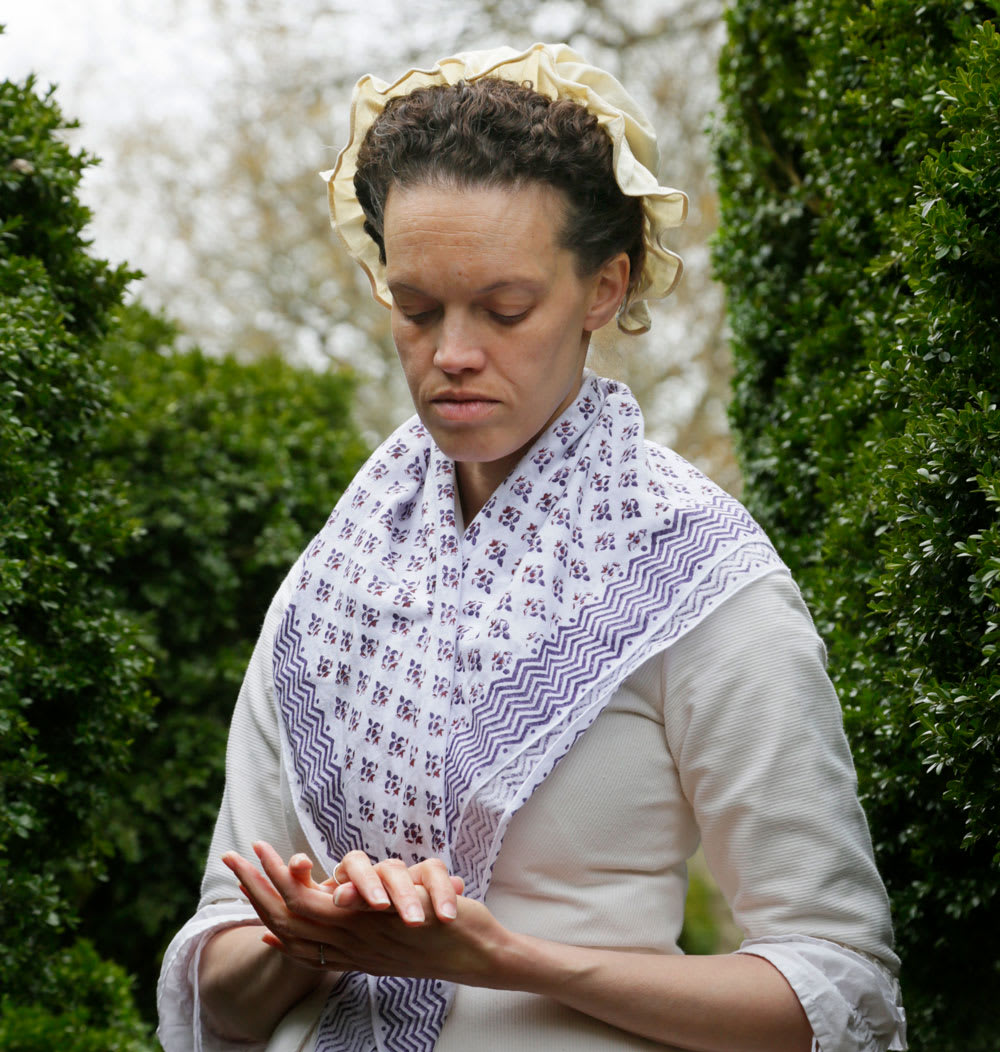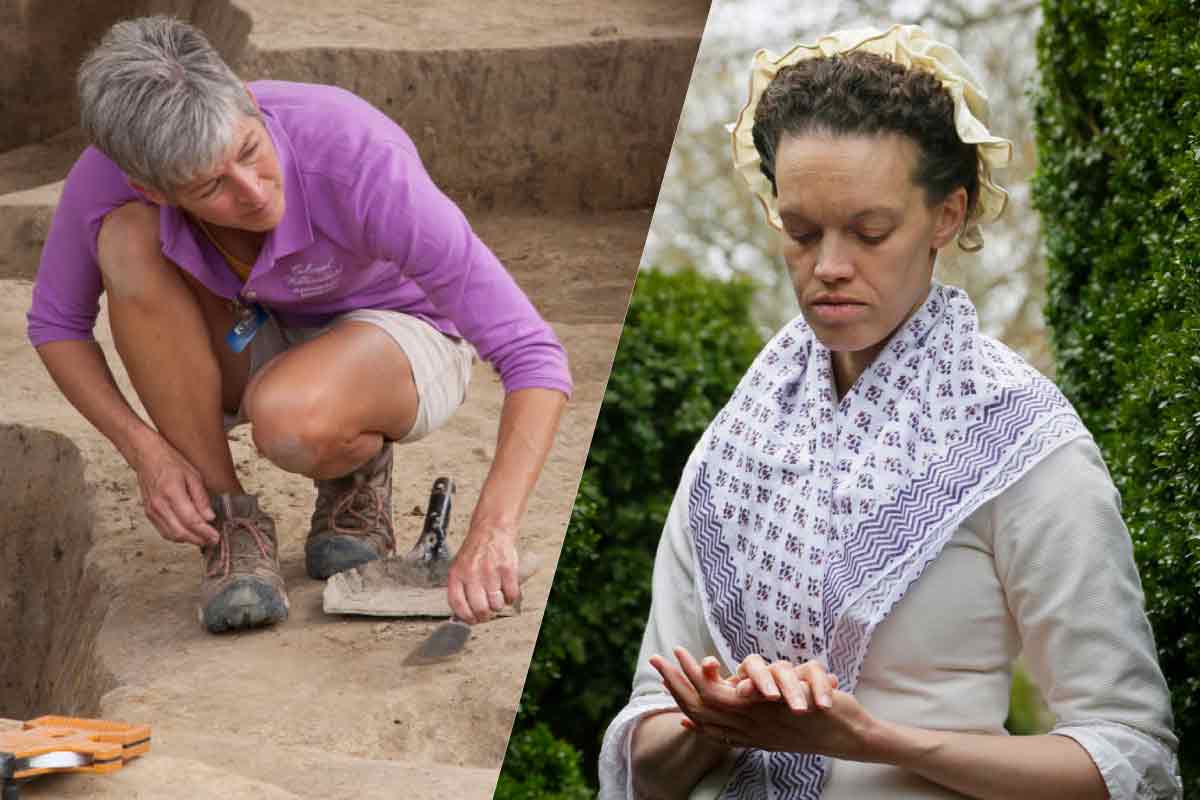Meredith Poole is an archaeologist who recovers artifacts from the lives of people long since past. Mary Carter is an actor who presents the life of a person from fragments left behind. Their roles may seem at opposite ends of the museum world. But when collaboration stems from their different perspectives, history truly comes to life.
Please note: this blog contains adult content.
Part I by Meredith Poole
“Artifacts are proof that the past happened”…. I read that somewhere, and I believe it to be true. A recovered artifact serves as a tangible link between one life and another, often separated by hundreds of years and vastly different experiences. This is where their powers lie. Artifacts can set the scene, fine-tuning the detail with which we imagine and connect with another person’s life.
As an archaeologist, I know the equation is more complicated than that. Artifacts do not easily become props. A ceramic fragment, for example, demands a form, as part of a tea bowl, or a plate, or a platter. Next, a value: was it an expensive item, purchased to impress? Was it discarded soon after purchase, while still highly prized, or did it survive long enough to be out-of-fashion, chipped and handed-down? What was it found alongside? Understanding an artifact’s “context,” — its association with other artifacts, is the only way to move from prop, to a story.

Archaeology involves more meticulous detail and recording than most people know. It’s what makes an archaeological report so difficult to read, with charts, soil descriptions, and statistics threatening to bury the very people whose lives we’re attempting to reveal. A trash pit should conjure not just an artifact inventory, but a smell (of emptied chamber pots and crab shells baking in the August sun) and a visual image (of a sodden, weedy, rodent-infested, corner). This story exists in the form of animal bones, phytoliths, and ceramic fragments. But connecting that information to a past human experience takes a knowledgeable translator.
Archaeologists are, of course, capable of doing these things. The interpretation section of any archaeological report takes a stab at describing what discoveries mean, although rarely with as much imagination, imagery, and (admittedly) embellishment, as this English major would choose. If not in creative language, where I think many archaeologists flex their interpretive superpowers is in introducing a scene’s “unseen” characters: the enslaved person at the other end of a recovered shovel blade; the hands that washed, polished, filled, delivered, and cared for artifacts that we identify as status markers: porcelain, watch parts, mirrors. Without these reminders, our view rests solely on the purchaser. Early in my career, I remember slogging through written descriptions of individual fencepost holes in a Peyton Randolph report. Not until I reached the interpretation, which considered the effects that those fences had in keeping people apart, did I fully appreciate their meaning. Connecting with the past requires both a translator and an interpreter.
Connecting with the past requires both a translator and an interpreter.
We all tell the stories we have to tell in the native language of our own discipline. As an archaeologist, I can supply endless detail and can facilitate connection between that evidence and past human experience. What I am less good at doing is bringing that information to life for a living, breathing audience—fostering an emotional connection to the story. That magic does not happen in the pages of a technical report.
During the winter of 2018, Mary Carter arrived in my office with a stack of archaeological reports and a problem. The immediate problem was deciphering the reports. Mary wanted guidance in selecting an artifact—a teacup, a button, any small bit of evidence—to connect her character, Aggy, to the Turkey Island site where Aggy was enslaved. A simple request became a two-hour conversation, during which we discovered how much Mary’s work, portraying a poorly documented enslaved woman, and mine, as an archaeologist, have in common.
This is where partnership begins.
Part II by Mary Carter
I don’t think about much while I am dressing. I try not to think about anything… I have been doing this work for 12 years and there is no romance for me in 18th-century clothing. I have a beautiful powder blue gown that I wear sometimes. While wearing it one day, a little girl asked me if I was an angel. I told her, “not exactly.”
I have no written accounts that tell me what Aggy wore each day. Did she dress like an angel? Aggy was enslaved and the legal property of a man named Ryland Randolph. If not for Ryland’s will, she might have disappeared entirely from the record. I have spent the last eight years of my life trying to breathe life into this woman that history forgot.
I have spent the last eight years of my life trying to breathe life into this woman that history forgot.
My work in researching and portraying a woman who was enslaved and singled out for sexual intimacy in the 18th century has me asking a lot of questions. How many steps were there to get to the second floor of The Birdcage, the house at Turkey Island Plantation? Was there a spiral in the stem of the glasses, like the ones they found at the Coffeehouse in Williamsburg? Did they ever keep birds in cages or are the accounts about the small black birds that flew in and out of the cupola the only reason for the nickname of the house? How many plates of china would one need to entertain in a place like this?

Ryland attempted to free Aggy in his will and leave her and her two children money and life away from the slavery she was born into. Within weeks of Ryland’s death though, his family denied his wishes and did everything they could to prevent Aggy from getting anything. It would take her five and a half years to get that freedom. That must have been a huge relief. But, even still, so much had already been stripped away.
The documentation about Aggy starts with Ryland’s death, but I rarely portray Aggy after that point. So, what was Aggy’s life like in the household of Ryland Randolph? What did she see, smell and hear as every object at Turkey Island was sold at auction? Did she know then that soon they would also put every enslaved person who lived at the plantation up for sale, including Aggy and her children?
In my life and in my work, details matter. For instance, I remember the color of the shirt my husband wore the first day I met him. I recall the taste of the brand of cigarette of the man who tried to rape me at a party in high school. These experiences are all a part of breathing life into the story of who I am today. And the evidence that remains at Turkey Island is a part of what it meant to be Aggy 240 years ago and speaks directly to how I portray Aggy.
The house at Turkey Island Plantation no longer stands, and the accounts of it only get me so far. But the evidence is there. I had not one, but two archeological reports from the site and I could not read a single word of them. So, I sought out Meredith Poole in hopes that she could tell me more about the world Aggy existed in.
The type of materials used in the construction of his home tell me about his education. The fragments of china can tell me how fashionable his tastes were. The use of his property, from the deer park to the space for the farming fields, can tell me more about how well he managed his land holdings and his money. All of this leads me to understand the fight Aggy had against Ryland’s family for freedom when they said Ryland’s debts were so great that she and her children (Ryland’s children) would have to remain enslaved.
Without surviving journals or farm books that Ryland and Aggy left behind, there are parts of this story that I will never fully see. But the objects in their lives play a role in all of it.
Unfortunately, the archeology that was done at Turkey Island was only preliminary. And those fragments of the life of a woman who was born and lived through bondage, chosen for physical intimacy, and forced to fight for freedom, are still trapped beneath the surface. But I look to the work that is being done at Custis Square by Meredith and others for clues. Though not related, John Custis IV was from the same world as Ryland and freed a child who he called, “my favorite boy Jack.” I wonder what life was like for Alice - Jack’s mother, when she was enslaved and lived at Custis Square. I have a lot of questions…
Meredith Poole has been a Staff Archaeologists at Colonial Williamsburg for 34 years. Her career started with the 1985 excavation at Shields Tavern and has continued through more recent projects at Charlton’s Coffeehouse, the Public Armoury, and the Market House. Meredith has shared her enthusiasm for archaeology in a variety of forms: managing the Reconstruction Blog, leading archaeological walking tours along Duke of Gloucester Street, and overseeing the Kids Dig on Duke of Gloucester Street. The Custis Square excavation, now in its second year, gives her an opportunity to research the enslaved people who built and knew that landscape. She lives in Williamsburg with her husband, Joe. They have two adult children.
Mary Hardy Carter has worked at The Colonial Williamsburg Foundation for 12 years. Over that last 10 years she has portrayed a variety of free and enslaved women, including Ona Judge Staines in the 2015 Emmy award winning Electronic Field Trip: Freedom Quest of Oney Judge. For the last 9 years her research has focused on slavery and the law, sex across the colors lines, and issues of race, racism and bias in historical and present society. She lives in Williamsburg with her husband and two children.
